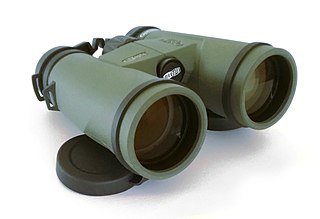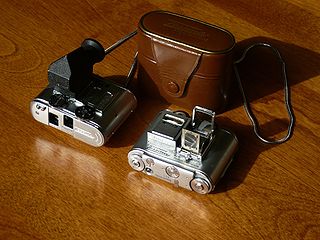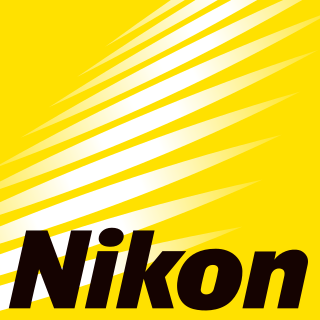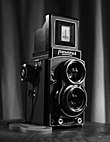
Bausch & Lomb is an American-Canadian eye health products company based in Vaughan, Ontario, Canada. It is one of the world's largest suppliers of contact lenses, lens care products, pharmaceuticals, intraocular lenses, and other eye surgery products. The company was founded in Rochester, New York, in 1853 by optician John Bausch and cabinet maker turned financial backer Henry Lomb. Until its sale in 2013, Bausch + Lomb was one of the oldest continually operating companies in the United States.

Binoculars or field glasses are two refracting telescopes mounted side-by-side and aligned to point in the same direction, allowing the viewer to use both eyes when viewing distant objects. Most binoculars are sized to be held using both hands, although sizes vary widely from opera glasses to large pedestal-mounted military models.

A monocular is a compact refracting telescope used to magnify images of distant objects, typically using an optical prism to ensure an erect image, instead of using relay lenses like most telescopic sights. The volume and weight of a monocular are typically less than half of a pair of binoculars with similar optical properties, making it more portable and also less expensive. This is because binoculars are essentially a pair of monoculars packed together — one for each eye. As a result, monoculars only produce two-dimensional images, while binoculars can use two parallaxed images to produce binocular vision, which allows stereopsis and depth perception.

Carl Zeiss AG, branded as ZEISS, is a German manufacturer of optical systems and optoelectronics, founded in Jena, Germany in 1846 by optician Carl Zeiss. Together with Ernst Abbe and Otto Schott he laid the foundation for today's multinational company. The current company emerged from a reunification of Carl Zeiss companies in East and West Germany with a consolidation phase in the 1990s. ZEISS is active in four business segments with approximately equal revenue in almost 50 countries, has 30 production sites and around 25 development sites worldwide.

Subminiature photography is photographic technologies and techniques working with film material smaller in size than 35mm film, such as 16mm, 9.5mm, 17mm, or 17.5mm films. It is distinct from photomicrography, photographing microscopic subjects with a camera which is not particularly small.

Pentax Corporation was a Japanese camera and optical equipment manufacturer, and currently, it exists as the Pentax Life Care Business Division of Hoya's medical endoscope business, as well as the digital camera brand of Ricoh Imaging, a subsidiary of Ricoh.

Nikon Corporation is a Japanese optics and photographic equipment manufacturer headquartered in Tokyo, Japan. The companies held by Nikon form the Nikon Group.

Rollei was a German manufacturer of optical instruments founded in 1920 by Paul Franke and Reinhold Heidecke in Braunschweig, Lower Saxony, and maker of the Rolleiflex and Rolleicord series of cameras. Later products included specialty and nostalgic type films for the photo hobbyist market.

Bell and Howell is a U.S.-based brand of cameras, lenses, and motion picture machinery. Originally founded as a company in 1907, headquartered in Wheeling, Illinois. Since 2010, the brand name has been licensed for a variety consumer electronics products.

A stereo camera is a type of camera with two or more lenses with a separate image sensor or film frame for each lens. This allows the camera to simulate human binocular vision, and therefore gives it the ability to capture three-dimensional images, a process known as stereo photography. Stereo cameras may be used for making stereoviews and 3D pictures for movies, or for range imaging. The distance between the lenses in a typical stereo camera is about the distance between one's eyes and is about 6.35 cm, though a longer base line produces more extreme 3-dimensionality.

Panavision is an American motion picture equipment company founded in 1954 specializing in cameras and lenses, based in Woodland Hills, California. Formed by Robert Gottschalk as a small partnership to create anamorphic projection lenses during the widescreen boom in the 1950s, Panavision expanded its product lines to meet the demands of modern filmmakers. The company introduced its first products in 1954. Originally a provider of CinemaScope accessories, the company's line of anamorphic widescreen lenses soon became the industry leader. In 1972, Panavision helped revolutionize filmmaking with the lightweight Panaflex 35 mm movie camera. The company has introduced other cameras such as the Millennium XL (1999) and the digital video Genesis (2004).
Cooke Optics Ltd. is a camera lens manufacturing company based in Leicester.

Norita was a Japanese optical manufacturer. Founded in 1951 by Toshio Norita, it originally made lenses for binoculars but moved on to prisms and thence pentaprisms for SLR cameras.
Bushnell Corporation is an American firm that specializes in sporting optics and outdoor products. It is based in Overland Park, Kansas and is a wholly-owned subsidiary of Vista Outdoor. Bushnell makes binoculars, telescopes, spotting scopes, riflescopes, red dot sights, GPS devices, laser rangefinders, game cameras, night-vision devices and other optical equipments.

Anamorphic format is the cinematography technique of shooting a widescreen picture on standard 35 mm film or other visual recording media with a non-widescreen native aspect ratio. It also refers to the projection format in which a distorted image is "stretched" by an anamorphic projection lens to recreate the original aspect ratio on the viewing screen. The word anamorphic and its derivatives stem from the Greek anamorphoo, compound of morphé with the prefix aná. In the late 1990s and 2000s, anamorphic lost popularity in comparison to "flat" formats such as Super 35 with the advent of digital intermediates; however, in the years since digital cinema cameras and projectors have become commonplace, anamorphic has experienced a considerable resurgence of popularity, due in large part to the higher base ISO sensitivity of digital sensors, which facilitates shooting at smaller apertures.

Întreprinderea Optică Română, often abbreviated by the acronym IOR, is a major optics company established in 1936 in Bucharest. IOR produces military and civilian-grade optics and associated equipment for export and domestic production. The company is known in North America particularly for its riflescopes, binoculars and other sporting optics, which often accompany Romanian military equipment sold on the North American market, such as the PSL rifle.
Vortex Optics is an American manufacturer of special optical equipments for hunting, wildlife watching, outdoor recreation, shooting sports and law enforcement and military. Vortex products include binoculars, spotting scopes, riflescopes, reflex sights, holographic sights and other accessories. It once had a sister company known as Eagle Optics, which developed high quality optics for birdwatchers.
NOBLEX E-Optics GmbH, formerly Docter Optics, is a German manufacturer of optics, including binoculars, rifle scopes, spotting scopes, red dot sights, flashlights and reading glasses. Its headquarters are in Eisfeld, Thuringia, Germany, where most of the products are developed and manufactured. Docter is part of the Analytik Jena Group.

Flexaret is a brand of cameras manufactured from 1939 to 1970 in Czechoslovakia by the company Meopta. All models of Flexaret are twin-lens reflex cameras with aluminum body, taking square "6×6" format photographs on a 120 roll film. Some models were also capable of using 35 mm film with the help of a special adapter.



















